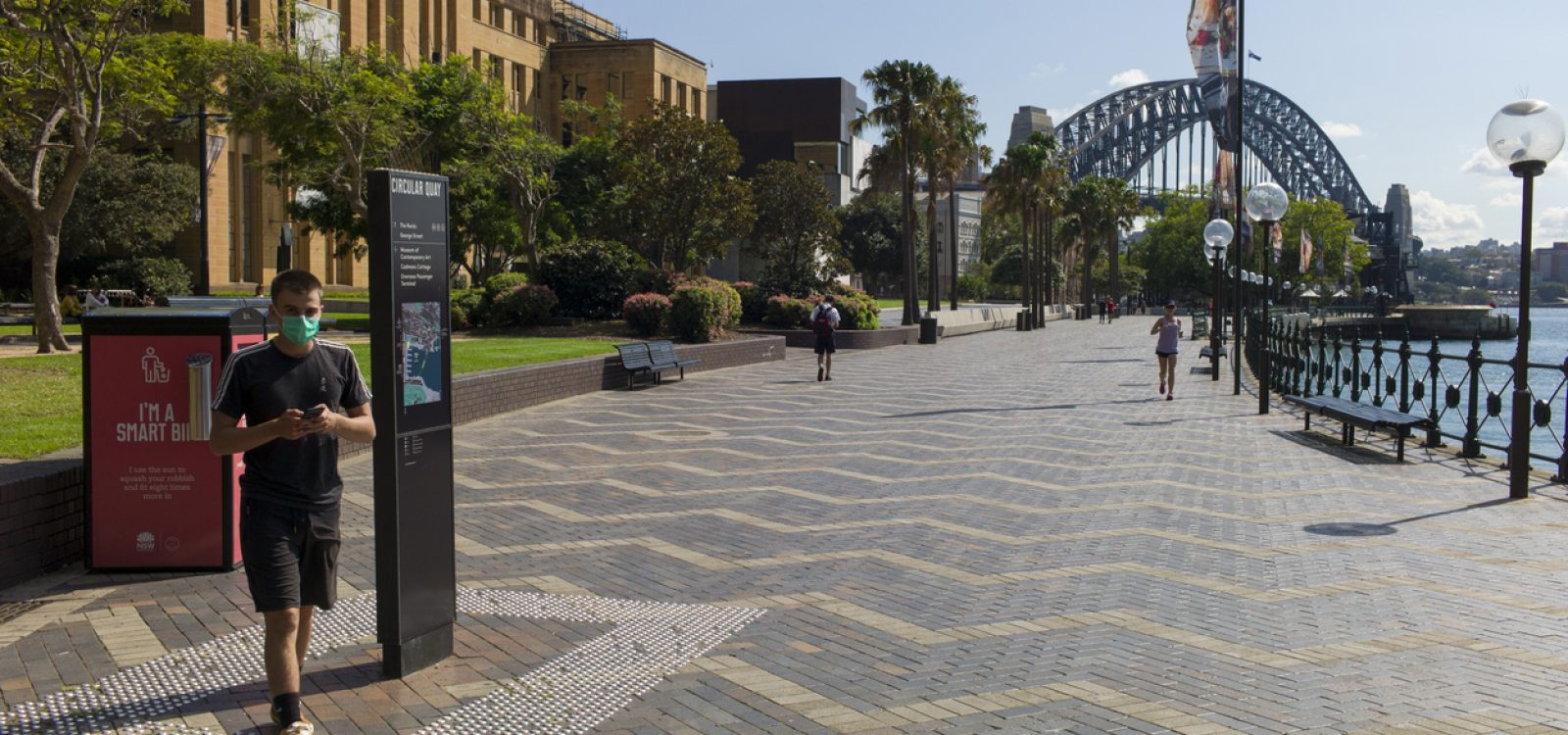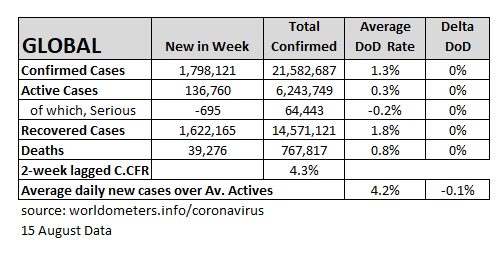
COVID-19 Monday Roundup 17 August 2020
Despite another week of record COVID-19 numbers globally, acceleration of the outbreak seems to be slowing while in Australia, Victoria appears to be past the ‘peak’. Sadly, New Zealand’s surprise outbreak remains unexplained. Russia approved a vaccine despite no Phase Three trials, while in the UK, modellers estimate that mortality and morbidity would have been at least three times higher without a lockdown, even after allowing for all the health effects of lockdown and a lockdown-induced recession.

World Summary – 15 August
There were record new cases again this week, but in a positive sign, the rate at which new cases are growing fell for a second week in a row to 1.3%.
- 62% of new cases were in India, USA and Brazil; and 25% were in just 16 other countries with over 10,000 new cases each, headed by Colombia with 80,000, 4.4% of the weekly total. USA and Brazil have peaked on new cases and probably also deaths, but have not yet established control.
- USA, Brazil, India, Peru and Mexico accounted for 78% of all deaths this week with over 4,000 deaths each. Another four countries had over 1,000 deaths each.
- In addition to India, there are large (over 60,000 total cases) uncontrolled outbreaks in three other South American countries, two in Eastern Europe, two in S.E. Asia and one in the Middle East. Elsewhere, large outbreaks have peaked, are coming under control or are controlled.
- The number of large uncontrolled outbreaks fell by one and the number of controlled large outbreaks rose by four.
- France, Netherlands and Belgium are experiencing potentially dangerous new surges that are yet to be controlled, while Spain appears to have capped its recent surge.
A very concerning development is the as-yet unexplained outbreak in otherwise COVID-free New Zealand, and the possibility that the virus can persist on surfaces longer than anticipated. This would significantly increase the challenge of controlling the virus’ spread.
Australia Summary – 16 August
Australia recorded 2,203 new cases this week (3,188 last week), taking total case numbers to 23,286. Overseas travellers accounted for only 23 cases (12 last week).
Victoria again dominates the numbers, recording 2,105 cases (3,102 last week). The considerably lower numbers likely reflects the impact of mandated mask usage, plus the beginnings of the impact of Stage Four restrictions.
While total numbers were down considerably, new cases diagnosed in health & aged care workers accounted for 618 cases (29%), similar to the previous week (610 cases). Exact numbers of new aged care residents diagnosed are not available, but estimates are of around 300-400 new cases, similar to last week; the total number of aged care residents diagnosed is now 1,471.
Regional Victoria recorded 117 new cases this week, down from 228 last week. There have been some sizable clusters in regional Victoria, and the reduction in numbers reflects those clusters coming under control.
Victoria recorded 100 deaths this week, up from 86 last week. Of those, 73 deaths were associated with outbreaks in aged care.
NSW recorded 75 locally acquired cases this week (69 last week). These were made up of:
- 22 cases from Tangara School (three last week, total 25).
- Three cases from Our Lady Mercy College (one last week, total four).
- Five cases in residents returned from Victoria (five last week).
- 34 cases linked to known clusters/cases.
- Four cases from two new new clusters, both with an unknown source of transmission in the initial case.
- Seven other cases with an unknown source of transmission. In total there were Nine cases with an unknown source of transmission this week, the same number as last week.
NSW also recorded two deaths this week.
No other state/territory reported any locally acquired cases this week, noting the scare in South Australia associated with the Thebarton College cluster has passed (all contacts were released from hotel quarantine on Saturday).
Key market update
- The Special Commission of Inquiry into the Ruby Princess released its final report this week, highlighting multiple errors made by NSW Health, but falling short of offering recommendations that might prevent similar situations. The COVID-19 Hotel Quarantine Inquiry in Victoria continues.
- Official unemployment rose to 7.5% in July 2020 even as the number of employed people increased by 114,700. Total payroll jobs were flat across Australia in July with Victoria seeing a 1.5% fall ahead of Stage Four restrictions.
- The RBA’s latest Statement on Monetary policy forecasts GDP to reduce by 6% in 2020 and unemployment rising to 10% over the next six months.
- Following the tighter restrictions in Victoria, changes to JobKeeper will help more businesses qualify, including a change to the employee reference date and a change to the reference turnover period.
- APRA will recommence public consultations on some policy reforms as well as a phased resumption of issuing new licenses. Wayne Byres reflected on APRA’s significantly adjusted operations to manage the impact of the COVID-19 crisis.
- ASIC published expectations of lenders to assist them to deliver appropriate and fair outcomes to consumers whose six-month loan repayment deferrals will expire in the coming months. APRA issued a consultation letter regarding ADI capital measures and reporting requirements for loans impacted by COVID-19.
- ASIC reminded responsible entities of their obligation to ensure valuations of managed fund assets are regular and reasonably current having regard to the nature of the assets.
- The Insurance Council of Australia (ICA) filed a test case in the NSW Supreme Court regarding certain infectious diseases exclusions in business interruption policies. Meanwhile in the US, the debate rages regarding business interruption with rulings in favour of insurers and insureds over the last few weeks.
- KPMG assessed the Economic impact of Victoria’s Stage 4 restrictions, and offered insight into JobKeeper 2.0 and the RBA economic forecast.
- MinterEllison have investigated the impact that COVID-19 on offshoring and overseas outsourcing.
New COVID-19 research this week
- Russia has approved a COVID-19 vaccine and will begin vaccinating health care workers and teachers this month. The vaccine ‘sped through early monkey and human trials with apparent success,’ but has not been studied in a Phase Three trial, which most countries consider essential before approval. There are now eight vaccine candidates in Phase Three trials.
- Both mRNA-based and adenovirus-based COVID-19 vaccines have proved effective in protecting nonhuman primates when directly challenged with the SARS-CoV-2 virus.
- Immunity. People previously exposed to certain common cold viruses may have some immunity response to SARS-CoV-2. This may explain why 20% to 50% of people in studies have shown some T-cell reactions to SARS-CoV-2, despite never being exposed to it.
- Preventing spread. Expired and poorly fitting N95 respirators have more than 90% filtration efficiency and perform better than most surgical and procedure masks, particularly those secured with elastic ear loops which had just 38% efficiency.
- Nursing homes in the US that had the highest levels of nurse staffing had fewer cases of COVID-19. Nurse staffing shortages may well be a critical factor in COVID-19 spread.
- Data from Wuhan suggests the mean incubation period after exposure may be almost eight days (currently assumed to be five), and up to 10% of cases may emerge after the standard 14 days quarantine period.
- This pre-print article summarises emerging research that suggests children may be important spreaders of the virus, so risk reduction strategies in schools may be needed..
- Frontline healthcare workers are over 10% more likely to contract COVID-19 compared to the general community, according to a UK/ US study, which suggested that adequacy of PPE, clinical setting and ethnic background are important factors.
- Modelling. The UK Government estimates that mortality and morbidity from COVID-19 would be three times higher if there had been no lockdown, even after taking into account all the impacts on health of lockdowns and a lockdown-induced recession.
- Modelling of strategies to re-open UK schools shows the impact of testing and contact tracing. For example, if 68% of contacts could be traced, 75% of individuals with symptomatic infection would need to be tested and positive cases isolated to avoid a second wave.
- Victoria’s response to a resurgence of COVID-19 is estimated to have averted 9,000-37,000 cases in July 2020.
- Provisional deaths data show Australia recorded around 624 excess deaths above normal levels in the three weeks to 7 April. Deaths from pneumonia were above historic levels during that time, with deaths from diabetes also remaining high.
- This Serotracker Dashboard synthesises data from seroprevalence testing around the world, with results for over 5.3 million tests in 27 countries included to date.
- Reports from South Africa, have again highlighted that COVID-19 fatalities are, on average, being under-reported. Perhaps only 26% of excess deaths from COVID-19 are being captured in South Africa’s official counts.
- Treatments. Extracorporeal membrane oxygenation (ECMO) has shown some improvement in outcomes in COVID-19 patients with severe respiratory failure despite.
- Long-term health effects. Evidence is emerging of potential long-term consequences of SARS-CoV-2 on the brain.
- The unusual. Demand for rescue dogs has surged during lockdowns in Australia with RSPCA Victoria reporting dogs are leaving the shelter in half the usual time.
- Meanwhile the COVID-19 lockdowns causedglobal seismic noise to halve around the world.
New on the Actuaries Institute website this week.
CPD: Actuaries Institute Members can claim two CPD points for every hour of reading articles on Actuaries Digital.






